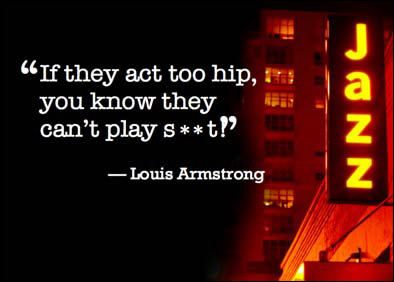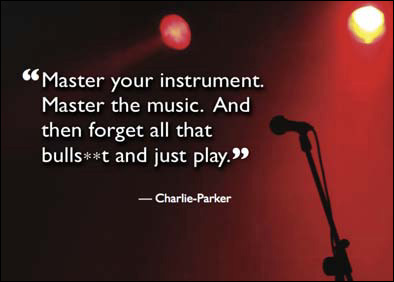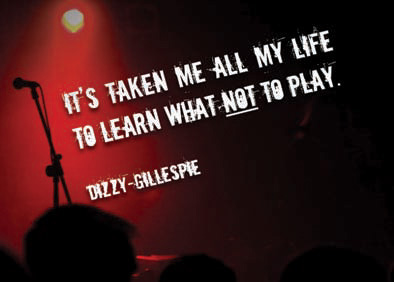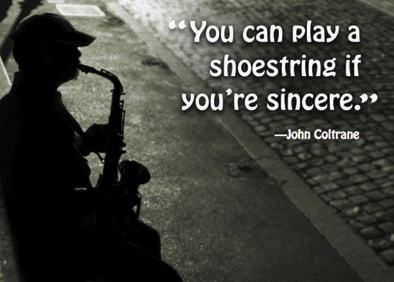Presentation Zen: Simple Ideas on Presentation Design and Delivery, 2nd Edition (Ira Katz's Library) (31 page)
Authors: Garr Reynolds

Photo of Tom Grant by Owen Carey.
There is a line of thinking that says if I tell you the meaning of Zen, then it wouldn’t really be Zen. The same could be said concerning the meaning of jazz. Of course, we can talk about them and label them. With our verbalization, we get close to the meanings—and the discussion may be interesting, helpful, and even inspiring. Yet we never experience the thing itself by talking about it. Zen is concerned with the thing itself. Zen is about the now—right here, right now. The essence of jazz expression is like this, too. It’s about this moment. No artificiality, no pretending to be anything you’re not. No acting. No wishing at this moment to be anywhere or with anyone except where you are.
While there are many forms of jazz, if you want to at least get close to the essence of the art, then listen to the 1959 album
Kind of Blue
by Miles Davis. The liner notes for this classic album were written by the legendary Bill Evans, who plays piano on the recording. In these notes, Bill makes a direct reference to one of the Zen arts,
sumi-e
. Here are just a few lines from his notes:
“There is a Japanese visual art in which the artist is forced to be spontaneous. He must paint on a thin stretched parchment with a special brush and black water paint in such a way that an unnatural or interrupted stroke will destroy the line or break through the parchment. Erasures or changes are impossible. These artists must practice a particular discipline, that of allowing the idea to express itself in communication with their hands in such a direct way that deliberation cannot interfere.”
I always thought there was a sort of aesthetic to this album that expressed the tenets of restraint, simplicity, and naturalness—principles that are at the heart of the Presentation Zen approach as well. In the music you hear a free yet structured spontaneity, an idea that seems oxymoronic until you study one of the Zen arts—or jazz. A free yet structured spontaneity is exactly the kind of state we want to be in with an audience during a presentation.
You can establish better connections with an audience by bringing the spirit of jazz to your talk. By “spirit of jazz,” I mean the complete opposite of how people usually use the term
jazz
—as in “jazz it up,” that is, decorate it or add something on the surface. The spirit of jazz is about honest intention. If the intent is pure and the message clear, then that is all you can do. Jazz means removing the barriers and making it accessible, helping people to get your expression (your message, story, point). This does not necessarily mean you will always be direct, although this is often the clearest path. Hint and suggestion are powerful, too. The difference is that hint and suggestion with intent have a purpose and are done with the audience in mind. Hint and suggestion without intent or sincerity may result in simplistic, ineffective ramblings or even obfuscation.
Jazz makes the complex simple through profound expressions of clarity and sincerity. It has structure and rules but also great freedom. Above all, jazz is natural. It is not about putting on a façade of sophistication or seriousness. In fact, humor and playfulness are also at the core of jazz. You may be a dedicated, serious musician or you may be an appreciative fan, but either way you also understand that to be human is to laugh and to play—play is natural to us and natural to the creative process. It’s only through our formal education that we begin to doubt the “seriousness” of play. When this happens, we begin to lose a bit of ourselves, including our confidence and a bit of our humanity. I’ve found through my parallel studies of jazz and the Zen arts that both have structure and practice at their core along with a strong component of playfulness and laughter—all elements we would like to bring to our presentations as well.
Quotes from Jazz
Jazz is about dialogue. It’s about making connections and being fully in the moment. When discussing this point in live presentations, I often introduce quotes by famous musicians. The four quotes on the slides here speak to the art of presentation and making connections as well. (Embedded slide images from iStockphoto.com.)
With practice we can become more polished. But too much polish turns a presentation into a TV-like infomercial unworthy of an audience’s trust. Presentation is a very human thing. Practice, rehearse, and make it great. But keep it real. Keep it human. And remember that it is about them (the audience), not us.

Studying design, presentation, and communication is crucial. Obviously, you must know your subject well. But when we present, all that matters is that moment and that audience. Get to the point. Tell them something memorable. Quit worrying and inspire them or teach them—or better yet, both.

Most presentations are too long or filled with unnecessary information that is included for the wrong reasons (such as fear). Knowing what to leave out takes work. Again, anyone can include everything and say everything. It is the master presenters (or writers, artists, and so on) who know what to exclude and have the courage to cut it.

In most situations, you don’t need the latest technology or the best equipment in the world. Showing that you are well prepared and ready to present naked, with or without technology, is far more important. A poor presentation is not any better simply because expensive equipment is used to project images. Sincerity, honesty, and respect for the audience matter far more than technology and technique.

To establish a connection with an audience, we must grab their attention right from the start. Granville N. Toogood, author of
The Articulate Executive,
also emphasizes starting off quickly and beginning with punch. “To make sure you don’t get off on the wrong foot, plunge right in,” he says. “To galvanize the mind of the audience, you’ve got to strike quickly.” I always urge people not to waste time at the beginning of a presentation with formalities such as long introductions or filler talk that is not related to the presentation’s goal. The beginning is the most important part. You need an opening that grabs people and brings them in. If you fail to hook them at the start, the rest of your presentation may be for naught.
The primacy effect in the context of presentations suggests that we remember more strongly what happens at the beginning of a presentation. There are many ways to strike quickly and start with punch to make a strong initial connection. In my book
The Naked Presenter
(New Riders), I introduced the idea of making a strong connection by incorporating into your opening content that which is personal, unexpected, novel, challenging, or humorous. Not coincidentally, these elements comprise the acronym PUNCH to help you remember. Most of the best presentations contain at least one or more of these elements. Let’s take a look at PUNCH in more detail.
PERSONAL
Make it personal. Personal in this case does not mean a long self-introduction about your background complete with organizational charts or why you are qualified to speak. A personal and relevant story, however, can be a very effective opening so long as it illustrates a key engaging point or sets the theme in a memorable way.
UNEXPECTED
Reveal something unexpected. Doing something or saying something that goes against what people expect gets their attention. Do or say something that taps into the emotion of surprise. This emotion increases alertness and gets people to focus. “There must be surprise...some key facts that are not commonly known or are counterintuitive,” says management guru Tom Peters. “No reason to do the presentation in the first place if there are no surprises.”
NOVEL
Show or tell something novel. Get people’s attention by introducing something new. Start with a powerful image that’s never been seen, reveal a relevant short story that’s never been heard, or show a statistic from a brand-new study that gives new insights into a problem. Chances are your audience is filled with natural born explorers who crave discovery and are attracted to the new and the unknown. Novelty is threatening for some people, but assuming the environment is safe and there is not an over abundance of novelty in the environment, your audience will be seeking the novel and new.
CHALLENGING
Challenge conventional wisdom or challenge the audience’s assumptions. Consider challenging people’s imaginations, too: “How would you like to fly from New York to Tokyo in two hours? Impossible? Well, some experts think it’s possible!” Challenge people intellectually by asking provocative questions that make them think. Many presentations and lectures fail because they simply attempt to transfer information from speaker to listener as if the listeners were not active participants.
HUMOROUS
Use humor to connect with the audience through a shared laugh. There are many benefits to laughter. Laughter is contagious. An audience that shares a laugh becomes more connected with each other and with you, creating a positive vibe in the room. Laughter releases endorphins, relaxes the whole body, and can even change one’s perspective. The old adage is if they are laughing, they are listening. This is true, although it does not necessarily mean they are learning. It is critical, however, that the humor be directly relevant to the topic at hand or otherwise fit harmoniously into the flow of the narrative without distracting you from the objective of your talk.
The concept of recommending humor in a presentation gets a bad rap because of the common and tired practice of opening up a speech with a joke, almost always a lame one. However, I’m not talking about telling jokes. Forget about jokes. On the other hand, an observation of irony, an anecdote, or a short humorous story that makes a relevant point or introduces the topic and sets the theme are the kinds of openings that can work.
There are many ways to start a presentation, but no matter how you choose to start, do not waste those initial valuable two or three minutes “warming up” the audience with filler material or formalities. Start strong. The five elements comprising PUNCH are not the only options to consider, but if your opening contains at least one of these approaches, then you are on your way to opening with impact and making a strong connection.